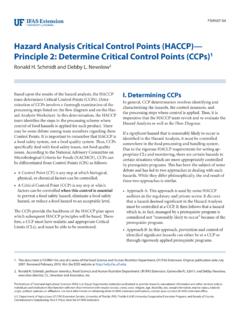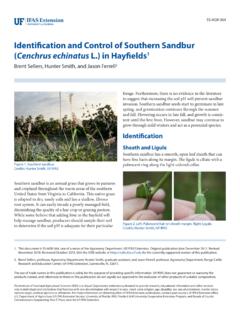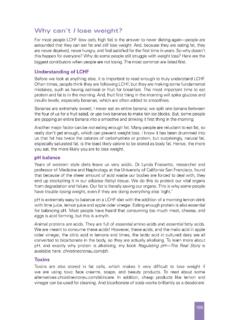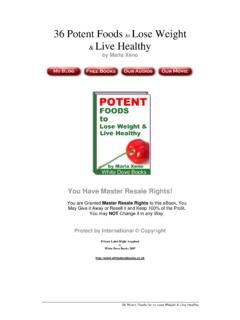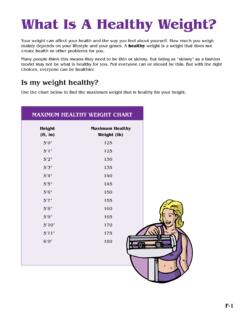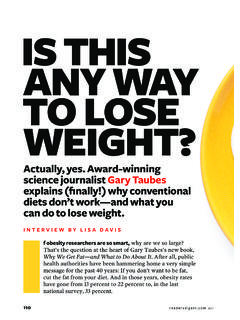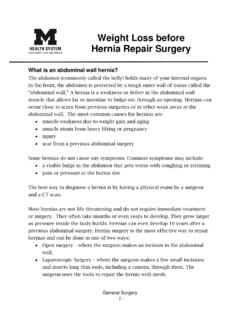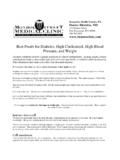Transcription of Healthy Meal Plans - EDIS
1 FCS8750 Healthy Meal Plans1 Linda B. Bobroff21. This document is FCS8750, one of a series of the Department of Family, Youth and Community Sciences, UF/IFAS Extension. Original publication date August 2002. Revised December 2017. Visit the EDIS website at Linda B. Bobroff, PhD, RDN, professor, Department of Family, Youth and Community Sciences, UF/IFAS Extension, Gainesville, FL Institute of Food and Agricultural Sciences (IFAS) is an Equal Opportunity Institution authorized to provide research, educational information and other services only to individuals and institutions that function with non-discrimination with respect to race, creed, color, religion, age, disability, sex, sexual orientation, marital status, national origin, political opinions or affiliations. For more information on obtaining other UF/IFAS Extension publications, contact your county s UF/IFAS Extension Department of Agriculture, UF/IFAS Extension Service, University of Florida, IFAS, Florida A & M University Cooperative Extension Program, and Boards of County Commissioners Cooperating.
2 Nick T. Place, dean for UF/IFAS is a meal plan ?A meal plan is a guide to help you plan daily meals and snacks. It allows you to eat foods you enjoy that provide a good balance of nutrients for your health. Meal Plans can be used by anyone interested in Healthy eating, and they are very helpful for people who want to manage their do meal Plans work?Each meal plan gives an example of one day s food intake using food lists that group foods based on the nutrients they contain. The meal Plans provide recommended amounts of food to eat from the five food groups in My-Plate: Vegetables, Fruits, Grains, Protein Foods, and Dairy. At the end of this publication, there are 14 different meal Plans based on varied calorie levels (1,200, 1,400, 1,600, 1,800, 2,000, 2,200, or 2,400 calories), each provided for a traditional or vegetarian eating style. Using one of the meal Plans as a guide, you can select foods from the food lists in this document (or more complete lists in Choose Your Foods: Food Lists for weight Management) to plan healthful and tasty meals and do food lists work?
3 Foods are grouped into lists according to their carbo-hydrate, protein, and fat content. Foods within each list contain similar amounts of total calories, carbohydrate, protein, and food lists are:Carbohydrates Starch Fruits Milk Fat-free, low-fat (1%) Reduced-fat (2%) Whole Other carbohydrates Non-starchy vegetablesMeat and Meat Substitutes Lean Medium-fat High-fat Plant-basedFatsMaking Healthy ChoicesWe recommend that you select a variety of nutrient-rich foods to make up your personal food plan . Nutrient-rich foods are those that provide plenty of nutrients, such as protein, vitamins, and/or minerals, along with calories (energy). Nutrient-rich foods are low in fat, especially solid fats, and added can check food labels to see the fat and sugar content of foods. Low nutrient-dense foods, like rich desserts, sugary drinks, and chips, provide calories with few other nutrients 2 Healthy Meal Plansneeded for good health.
4 We suggest you eat these foods less higher fat foods to stay at your target calorie level. Ounce for ounce, fat provides more than twice as many calories as protein or carbohydrates, and foods that are high in fat generally are high in calories. Check the food label since some low-fat foods are also high in calories!Setting Up Your Meal PlanFirst, decide your daily calorie goal. This may be to maintain your weight or to lose or gain weight . If you want to lose weight , select your calorie goal to lose no more than one to two pounds per week. A calorie deficit of about 500 calories a day will result in slow weight loss for most people. The best approach is to increase your physical activity and decrease your food intake by a few hundred calories each d weight loss is best for almost everyone trying to lose weight . For help in deciding your calorie goal, contact your county Extension Family and Consumer Sciences agent, a registered dietitian (RD or RDN), or a public health nutri-tionist.
5 You can find your energy (calorie) needs at , look at the meal plan closest to your calorie level and plan menus for one week using the sample menu as a guide. Choose foods available on the plan that you enjoy sure to include healthful snacks in your meal plan . They will help keep you from getting too hungry during the day. Also, every day drink at least nine cups of water or other non-sugary drinks, such as club soda, seltzer, unsweetened tea, or you begin selecting foods based on these meal Plans , think of it as a lifestyle change, or beginning a new way of eating rather than a diet that will end when you reach your body weight goal. Enjoy your meals , and invite your family and friends to share your new way of , include physical activity in your healthier lifestyle. Being active will help you maintain or achieve a Healthy body weight and keep you feeling fit and strong. Regular exercise also reduces health risks.
6 If you have not been active for a long time, check with your doctor before you start an exercise Food ListsComplete food lists are available in the publication Choose Your Foods: Food Lists for weight Management ( ). The following lists will get you started. The first five food lists are foods that provide starch choice provides: 15 grams carbohydrate 0 3 grams protein 0 1 gram fat 80 caloriesStarches include breads, cereals, starchy vegetables, crackers and snacks, and beans, peas, and lentils. These foods are found in the Grains, Vegetable, or Protein Foods groups of MyPlate. They provide a variety of vitamins and minerals, Figure 1. MyPlate can help you plan Healthy meals . Visit for tips on making Healthy food choices and resources to help you keep track of your food intake and physical : USDAF igure 2. Be sure to choose foods you enjoy! It will help you stick with your meal : Getty Images3 Healthy Meal Plansand many provide fiber.
7 Beans, peas, and lentils are also excellent protein starch is: cup of cooked cereals, grains, or starchy vegetables cup of cooked rice or pasta 1 ounce of bread to 1 ounce of most snack foods (some snacks also have fat)A few examples of one starch choice are:Some starchy foods are prepared with fat so they count as 1 starch and 1 fat:FRUITS1 fruit choice provides: 15 grams carbohydrate 0 grams fat and protein 60 caloriesThe Fruit list includes fresh, frozen, dried, and canned fruits. When you choose canned fruit, select fruit canned in juice or extra light syrup. Include at least one fruit high in vitamin C (oranges, grapefruits, berries, and melons) every d fruit is: 1 small fresh fruit (4 oz) to 1 cup of fresh fruit cup of canned fruit cup of unsweetened fruit juice 2 tbsp of dried fruitA few examples of one fruit choice are:MILK1 milk choice provides: 12 grams carbohydrate 8 grams protein 0 8 grams fat 100 160 caloriesMilk and yogurt are excellent sources of calcium and protein as well as several vitamins and other minerals.
8 Select fat-free or low-fat (1%) dairy and have 2 3 servings a day. Fortified soy milk is also a good source of calcium and protein; count 1 cup as a milk exchange and 1 fat exchange (light versions count as fat exchange).One milk is: 1 cup of fat-free or 1% milk (see chart) cup of plain fat-free or low-fat yogurtTable slice (1 oz)Bagel large (1 oz)Cereal (ready-to-eat, unsweetened) cupCereal (cooked) cupGranola cup (may have extra fat)Pasta1/3 cup, cookedBaked beans1/3 cupRice1/3 cup, cookedCorn cupPotato, baked or boiled large (3 oz)Dried beans and peas (cooked) cupTortilla, flour1 (6 inches across)Table bread, 1 -inch cube1 piece (1 oz)French fries1 cup (2 oz)Taco shell, 5 inches2 Figure 3. Fruits provide only 60 calories in one serving, along with vitamins, minerals, and fiber. They are naturally sweet and make great snacks or : Getty ImagesTable 3. small (4 oz)Blueberries cupCantaloupe1 cup, cubedPrunes, dried3 Strawberries, whole1 cup100% Orange juice cupTable of Milk or YogurtFat (grams)CaloriesFat-Free or Low-Fat (1%)0 3100 Reduced-Fat (2%)5120 Whole81604 Healthy Meal PlansIf you want to decrease your calorie intake, choose fat-free or low-fat milk and , DESSERTS, AND OTHER CARBOHYDRATES1 choice from this list provides: 15 grams carbohydrate Protein, fat, and calorie content variesFoods on this list include foods that contain added fat and/or sugar.
9 You may substitute foods on this list for a starch, fruit, or milk exchange. Choose the foods on this list less often because they are less nutrient-rich than foods on the other as 1 carbohydrate (either a Starch, Fruit, or Milk on your meal plan ):Count as 1 carbohydrate (either a Starch, Fruit, or Milk on your meal plan ) + 1 fat:NON-STARCHY VEGETABLES1 non-starchy vegetable choice provides: 5 grams carbohydrate 2 grams protein 0 grams fat 25 caloriesNon-starchy vegetables include fresh, frozen, or canned vegetables. Canned vegetables often contain added salt; you can rinse and drain them to remove some salt or choose low-sodium varieties. Deep green and orange vegetables provide vitamin A and other nutrients important for health. Several vegetables, including peppers, broccoli, and tomatoes, are rich sources of vitamin C. Starchy vegetables like corn, peas, and potatoes are not included here; they are on the starch list.
10 Have at least 2 3 servings a day of non-starchy non-starchy vegetable is: cup of cooked vegetables cup of vegetable juice 1 cup of raw vegetables (Raw salad greens are Free Foods, which are explained in a later section of this document.)MEAT AND MEAT SUBSTITUTES1 meat or meat substitute choice provides: 7 grams protein 0 8 or more grams fat 0 grams carbohydrate 45 100 caloriesMeat and meat substitutes are divided into four lists, depending on their fat content and source (animal or plant). Select lean meats and meat substitutes most of the time. Use low-fat cooking methods like broiling, roasting, baking, and grilling to limit added meat is: 1 ounce cooked meat, fish, poultry 1 ounce cheese cup cooked beans, peas, or lentils (count as 1 Meat + 1 Starch) 1 egg 1 tbsp peanut butter/nut spreadsA typical portion of meat often is three or more ounces since one ounce is a very small serving. For example, 3 ounces of meat is about the size of a deck of playing meat and meat substitutes include lean cuts of beef, pork, and other meats, chicken or turkey (no skin), game meats, fresh or frozen fish, canned salmon or tuna, egg whites or substitutes, and cheeses with 3 grams or less of fat per meat and meat substitutes include ground beef, meat loaf, short ribs, chicken with skin, fried chicken or fish, pork cutlet or shoulder roast, cheese with 4 7 grams of fat per ounce, and meat and meat substitutes are high in saturated fat and cholesterol.





